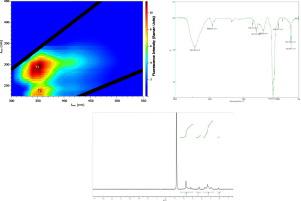Science of the Total Environment ( IF 8.2 ) Pub Date : 2021-09-17 , DOI: 10.1016/j.scitotenv.2021.150417 Francisco J Rodríguez-Vidal 1 , Beatriz Ortega-Azabache 2 , Ángela González-Martínez 2 , Ana Bellido-Fernández 2

|
The organic matter present in six industrial wastewaters (pulp and paper mill, brewery, textile, dairy, slaughterhouse effluents and a municipal landfill leachate) has been studied in this work using three analytical techniques: excitation-emission matrix fluorescence (EEMF), proton nuclear magnetic resonance spectroscopy (1H NMR) and Fourier transform infrared spectroscopy (FTIR).
The pulp and paper mill effluent shows characteristic signals of the presence of lignins, carbohydrates and carboxylic acids, as well as sulfate, carbonate and sulfonates (coming from surfactants used in the cleaning of tanks). The main constituents of the brewery effluent are peptides and proteins coming mainly from spent yeast and diatomite filters (the presence of the latter was confirmed by Si O bands in the FTIR spectrum). The municipal landfill leachate is characterized by the majority presence of humic substances (typical of an old landfill) and a residual presence of small peptides, amino acids and carboxylic acids. Additionally, several inorganic compounds were identified by FTIR, such as nitrate, sulfate, phosphate and cyanide ions. The textile effluent from a cotton-based industry contains carbohydrates, carboxylic acids and sulfonates, which can act as auxochromes in the textile industry. The dairy effluent comprises amino acids and small peptides coming from the biodegradation of milk and whey in addition to carbohydrates (lactose) and carboxylic acids (mainly lactic acid). The presence of tyrosine-like peaks B in the EEMF spectrum of the slaughterhouse effluent indicates the existence of small peptides and amino acids coming from the biodegradation of blood proteins. Additionally, residual glucose, fatty acids, phosphate and sulfate were also identified in this effluent.
O bands in the FTIR spectrum). The municipal landfill leachate is characterized by the majority presence of humic substances (typical of an old landfill) and a residual presence of small peptides, amino acids and carboxylic acids. Additionally, several inorganic compounds were identified by FTIR, such as nitrate, sulfate, phosphate and cyanide ions. The textile effluent from a cotton-based industry contains carbohydrates, carboxylic acids and sulfonates, which can act as auxochromes in the textile industry. The dairy effluent comprises amino acids and small peptides coming from the biodegradation of milk and whey in addition to carbohydrates (lactose) and carboxylic acids (mainly lactic acid). The presence of tyrosine-like peaks B in the EEMF spectrum of the slaughterhouse effluent indicates the existence of small peptides and amino acids coming from the biodegradation of blood proteins. Additionally, residual glucose, fatty acids, phosphate and sulfate were also identified in this effluent.
中文翻译:

使用 EEM 荧光、FT-IR 和 1H NMR 技术对工业废水进行综合表征
在这项工作中,使用三种分析技术研究了六种工业废水(纸浆和造纸厂、啤酒厂、纺织、乳制品、屠宰场废水和市政垃圾渗滤液)中存在的有机物:激发发射矩阵荧光 (EEMF)、质子核磁共振光谱(1 H NMR)和傅里叶变换红外光谱(FTIR)。
纸浆和造纸厂流出物显示出存在木质素、碳水化合物和羧酸以及硫酸盐、碳酸盐和磺酸盐(来自用于清洁储罐的表面活性剂)的特征信号。啤酒厂废水的主要成分是肽和蛋白质,主要来自废酵母和硅藻土过滤器(后者的存在由 Si FTIR 光谱中的 O 波段)。市政垃圾渗滤液的特点是大部分存在腐殖质(旧垃圾填埋场的典型特征)和残留的小肽、氨基酸和羧酸。此外,FTIR 还鉴定了几种无机化合物,如硝酸根、硫酸根、磷酸根和氰根离子。来自棉花工业的纺织废水含有碳水化合物、羧酸和磺酸盐,它们可以作为纺织工业中的助色素。除了碳水化合物(乳糖)和羧酸(主要是乳酸)之外,乳制品流出物还包含来自牛奶和乳清生物降解的氨基酸和小肽。屠宰场流出物的 EEMF 光谱中酪氨酸样峰 B 的存在表明存在来自血液蛋白质生物降解的小肽和氨基酸。此外,在该流出物中还发现了残留的葡萄糖、脂肪酸、磷酸盐和硫酸盐。
FTIR 光谱中的 O 波段)。市政垃圾渗滤液的特点是大部分存在腐殖质(旧垃圾填埋场的典型特征)和残留的小肽、氨基酸和羧酸。此外,FTIR 还鉴定了几种无机化合物,如硝酸根、硫酸根、磷酸根和氰根离子。来自棉花工业的纺织废水含有碳水化合物、羧酸和磺酸盐,它们可以作为纺织工业中的助色素。除了碳水化合物(乳糖)和羧酸(主要是乳酸)之外,乳制品流出物还包含来自牛奶和乳清生物降解的氨基酸和小肽。屠宰场流出物的 EEMF 光谱中酪氨酸样峰 B 的存在表明存在来自血液蛋白质生物降解的小肽和氨基酸。此外,在该流出物中还发现了残留的葡萄糖、脂肪酸、磷酸盐和硫酸盐。











































 京公网安备 11010802027423号
京公网安备 11010802027423号